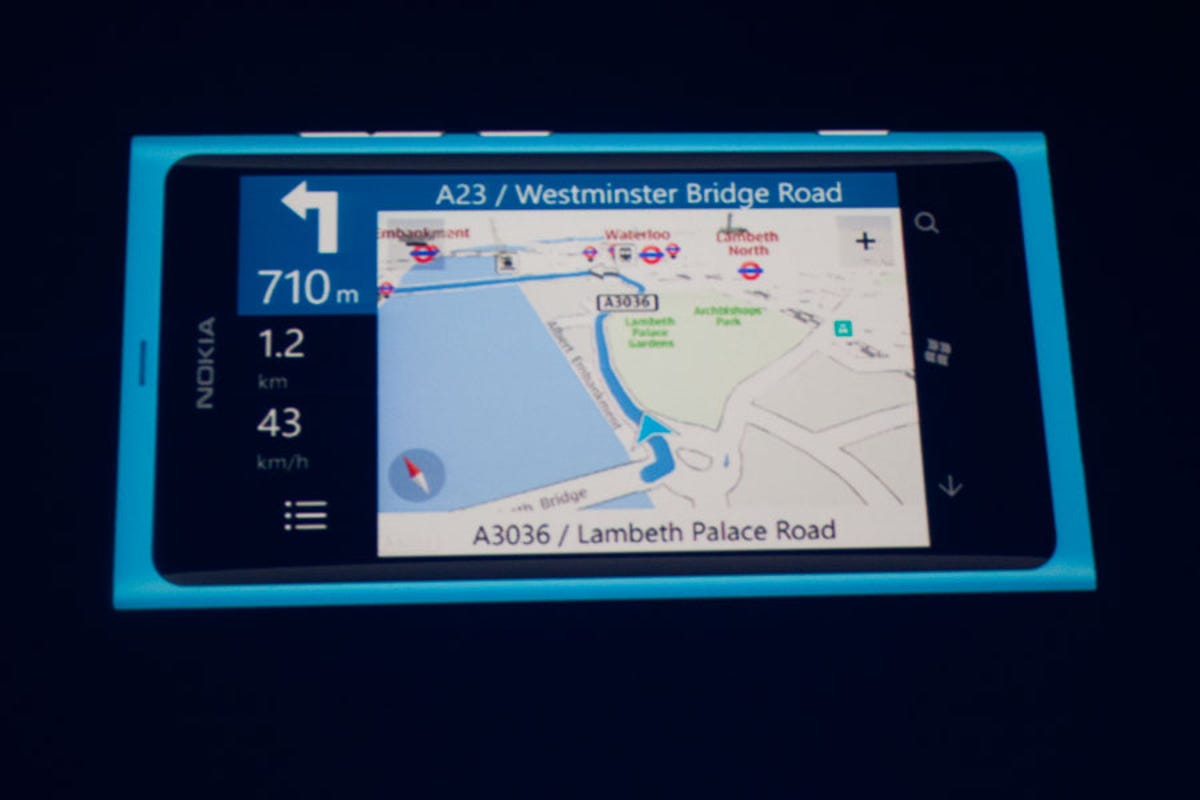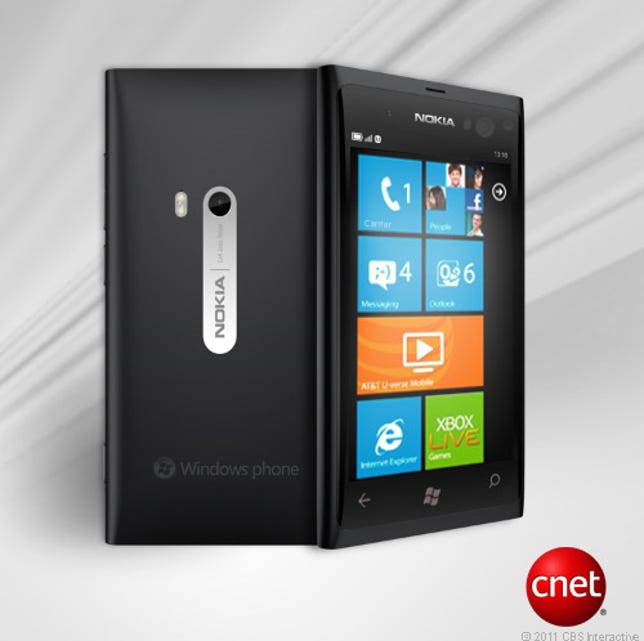Windows Phones just aren’t selling (only 1 percent in the U.S., according to Nielsen in June). The new Mango OS is nice enough, but with shelves awash with so many excellent Android phones, what Windows Phone badly needs is a hardware hit.
If Nokia has its way, the Lumia 800 and Lumia 710 will deliver it.
“It’s a new dawn for Nokia,” its CEO Stephen Elop said this week in London. “And we think we can break through.”
Nokia’s optimism and energy will certainly help. More important, so will its marketing dollars. Yet Nokia won’t going anywhere if it doesn’t produce the kinds of phones that people want to buy. On the surface, Nokia’s two first Windows Phones are promising starts, and now it’s time for a closer look. But I can already tell you this–it’s going to be a long, tough, uphill trek for the company.
Body
CNET’s Nicole Lee called the Lumia 800 a “unibody wonder”, and it is. A solid slab of richly-colored polycarbonate plastic that reminds me of an oversize stick of checking gum, the Lumia 800 is a daring, funky, and above all interesting design that you’re likely to either love or hate. At the very least, the phone’s either black, cyan, or magenta color pair nicely with the customizable OS colors you can pick in the Windows Phone display settings.
Related stories:
Lumia 800 hands-on: Unibody wonder
Lumia 710: Colorful Windows Phone personality
Can Nokia’s Lumia phones make it in the U.S.?
Flex it, baby! A seriously twisted new interface
An interesting feature in the Lumia 800’s unibody design is that the battery is also socked in to the plastic, along with all the other internal components. The advantage, other than a unique aesthetic, is that it creates a tighter seal between the screen and the outside world. You don’t hear many complaints from iPhone users about not being able to pop the battery for a hard reset, and Nokai sees it similarly. To hard-reboot the Lumia 800, you’ll press and hold the Power button longer than usual.
The Lumia 710 has a much more traditional, fairly compact candybar design (by today’s jumbo standards) that fits well in the hand. It gets its extra zing from the magenta, cyan, and yellow back covers you can swap in exchange for the black and white covers that come with the black and white phones.
So the physical chassis? Check! They’ll offer the market something new and interesting to look at and hold, and for better or for worse, the phones will visually stand apart


Nicole Lee/CNET
Screens
I certainly love the Lumia 800’s curved, glossy, and simply gorgeous 3.7-inch WVGA AMOLED display (800×480 pixel resolution) with Nokia’s ClearBlack filter to help increase contrast and sunlit readability. While it isn’t enormous, the screen is a definite win, and within range for comfortable reading and typing. This will keep keep the Lumia 800 competitive with the higher-end qHD phones, which can sometimes lack sharpness and richness despite their high resolutions.
The Lumia 710 shares the same screen size, WVGA resolution, and ClearBlack Display as the 800, but it uses an LCD panel instead of the AMOLED. It does pale in comparison to the higher-end AMOLED screen, but I thought it was totally acceptable. A more midrange screen cuts costs, which is exactly the goal with the mid-level Lumia 710.
Cameras
How well the Lumia 800 takes photos will be sticking point, especially as Nokia has a good reputation for strong cell phone cameras, and high-end camera phones are rapidly replacing separate point-and-shoot cameras among casual photographers. The Lumia 800’s specs sound impressive: an 8-megapixel camera that boasts an f/2.2 Carl Zeiss Tessar lens and comes with dual LED flash. There’s a wide-angle mode as well (16:9 ratio) that’s especially designed for taking sweeping landscape shots, and some basic editing tools to remove red-eye and reduce blur.
Nicole tested out the camera briefly during her hands-on time with the Lumia 800 and found that the camera took photos quickly, without much shutter lag. In addition, the camcorder records 720p HD video at 30 frames per second.


Nicole Lee/CNET
The real test will be comparing the Lumia 800’s camera prowess to other hotshot camera phones. Right now the iPhone 4S’ 8-megapixel camera and the Samsung Galaxy S II’s 8-megapixel shooter are among the ones to beat. Andrew Hoyle from CNET’s UK did just that, and declared the Lumia lacking. Take a look for yourself and you’ll find that while pretty good, the image quality wasn’t quite good enough. (Of course, our team here will also take our own complement of comparison photos once we get a test unit to bring back with us.)
For my part, I took a few test photos on the Lumia 710’s 5-megapixel camera during my hands-on time, and also found that photos looked pretty good, but didn’t seem as sharp or focused as they could have. It seemed to handle light well in the well-lit room, although I wasn’t able to get diverse enough lighting situations to lay down any lasting judgment.
In the end, Nokia needs to watch out–they could lose big on great-camera claims.
Processor
Both Lumias have a 1.4GHz single-core processor, which is pretty good. Dual-core processors are The Next Best thing of course, and usually the sign of a more premium handset, however there’s also the argument that a dual-core could be overkill for some handset models, and in my experience, a processor of this caliber remains nice and fast.
Still, until we see the first Nokia dual-core Windows-brand phone, Nokia (and Microsoft) will have to fight the expectation that smartphones worth top-dollar have two cores inside.
Storage
Since Windows Phones (like iPhones) don’t have microSD card slots, the storage capacity is important. The Lumia 800 has 16GB internal memory, which is on par with most other (but not all) currently available Windows Phones. The Lumia 710 has half that, 8GB, and both phones offer the typical 25GB free online storage through Microsoft’ SkyDrive.
It’s not bad at all, but I’m still looking for that one killer Windows Phone to have at least 32GB of internal storage, especially for media-lovers to get their movie fix, and for audiophiles to tap into Zune’s really great music integration.


Stephen Shankland/CNET
Apps
Nokia is taking the right steps to diversify their phones by offering three apps you won’t find with other carriers: the ESPN hub, Nokia Drive for turn-by-turn directions, and a music app that will do music mixes (this sounds similar to the OS’ SmartDJ feature) and streaming radio. Nokia Drive was the only one we were able to see, and the voice read-out wasn’t available on the demo device. Still, it’s a great addition that will help match Android’s turn-by-turn Google Maps navigation.
Pricing
Keep your ears pricked for pricing subsidies once these or other Nokia phones come to the U.S. For now, the Lumia 800’s unlocked price should be about $585 U.S. or 420 euros when it hits France, Germany, Italy, the Netherlands, Spain, and the UK in November.
The less pricey Lumia 710 will slide in at $370 (270 euros) for the unlocked model.
These are high prices by U.S. standards, where the majority of our population is used to paying less than half that for subsidized phones. The fact that you can buy a higher-end $99 Android smartphone or $99 iPhone 4 means that the pressure will be on–high–in the crowded and competitive U.S. market. For now, Nokia hasn’t announced anything official, but U.S. pricing will be key. Too high and on-the-fence consumers will continue to pick Android phones. Too low and the phones could come across looking too cheap.
What we didn’t get
Back in June, my colleague Bonnie Cha and I brainstormed what we wanted–and thought we’d get–in Nokia’s first Windows Phone. A front-facing camera, maybe a keyboard in one device, and a great screen resolution made the list, along with a fantastic camera and NFC capability. We were hoping it would be Microsoft’s first dual-core and first 4G-capable Windows Phone.
table.geekbox th{background-color:#E6ECEF;text-align:left;font-weight:bold;}
table.geekbox tr.even{background-color:#CCCCCC;}
.ratingGood{color:#093;} .ratingAverage{color:#666;} .ratingBad{color:#C00;}
| Nokia Lumia 800 | Nokia N9 | |
|---|---|---|
| Operating system | Windows Phone 7.5 Mango | MeeGo 1.2 |
| Display | 3.7-inch curved AMOLED | 3.9-inch curved AMOLED |
| Dimensions | 4.59 inches (116.5mm) by 2.4 inches (61.2mm) by 0.47 inch (12.1mm) | 4.59 inches (116.5mm) by 2.4 inches (61.2mm) by 0.47 inch (12.1mm) |
| Weight | 5.01 oz (142 grams) | 4.76 oz (135 grams) |
| Processor | 1.4GHz Qualcomm MSM8255 | 1GHz TI OMAP3860 |
| RAM | 512MB | 1GB |
| Storage | 16GB | 16GB or 64GB |
| Rear camera | 8-megapixel camera | 8-megapixel camera |
| Front camera | None | VGA |
| NFC | No | Yes |
(Credit: Nicole Lee/CNET)
It’s fantastic that Nokia has attempted Windows Phone’s first 8-megapixel lens, but apart from the shadow of doubt cast on this camera’s performance, the most disappointing omission is the Lumia 800’s lack of a front-facing camera. After all, there’s one in the Nokia N9, Nokia’s model for the Lumia 800, so why not here? I heard the general “we wanted to get a phone out fast,” but Nokia spokespeople didn’t share any satisfying explanations.
Nokia: There’s more to come
While there are already some disappointments–neither Lumia would survive spec-to-spec combat with today’s highest-end phones–the Lumias 800 and 710 are only the beginning. Nokia is getting started in Europe, where the brand is most valuable, but models will be announced for the U.S. by early 2012, most likely with a top-tier carrier.
Those phones that come stateside may be different too, Nokia hinted to CNET, or pumped-up variations of the Lumias CNET saw yesterday.


Josh Long/CNET
Revving Windows Phones
Nokia faces a heavy burden. It must revive its European presence as a stronghold of quality; it must successfully bring its smartphones to top-tier U.S. carriers; and it must push (or at least pull) Windows Phone’s brand along with it.
Luckily for Nokia, its brand cache is well-known in Europe, where an Orange executive recently described it to me as akin to “driving a Mercedes Benz.”
Yet Nokia’s other prospects grow dimmer when you consider that as of this summer, Windows Phone only succeeded in owning 1 percent of the U.S. smartphone market, according to that aforementioned Nielsen report this past June. Microsoft won’t share new sales figures until January, a spokesperson told CNET, but last January Microsoft had sold 2 million handsets to its distributors–not necessarily to real phone-toting people. In the meantime, Samsung reports that it has sold over 30 million Samsung Galaxy S II devices worldwide and Apple sold 4 million iPhone 4S units its opening weekend.
What has to happen next
I’ve said elsewhere that the two key ingredients that Microsoft needs for Windows Phone OS to succeed are: (1) really outstanding software features (the iPhone 4S has a killer camera and Siri; Android 4.0 Ice Cream Sandwich has facial unlocking and Android Beam); and (2) fantastic hardware that matches rivals’ top-notch specs.
With the Lumia line, Nokia is potentially off to a good start. It’s proving that it has the design chops to make Windows Phones stand out. Now it needs to go deeper and absolutely deliver on the specs that consumers expect for phones in the Lumias’ price ranges.
Whichever high-end phone Nokia announces for the U.S.–Microsoft’s home Windows Phone market–it must have a front-facing camera and that vibrant AMOLED screen, and the faster it is, the better it will be received. It’s too early to say whether Nokia will be able to push Windows Phone past the tipping point. Although there’s optimism all around, there are also enough soft spots to know that success isn’t remotely a given.



